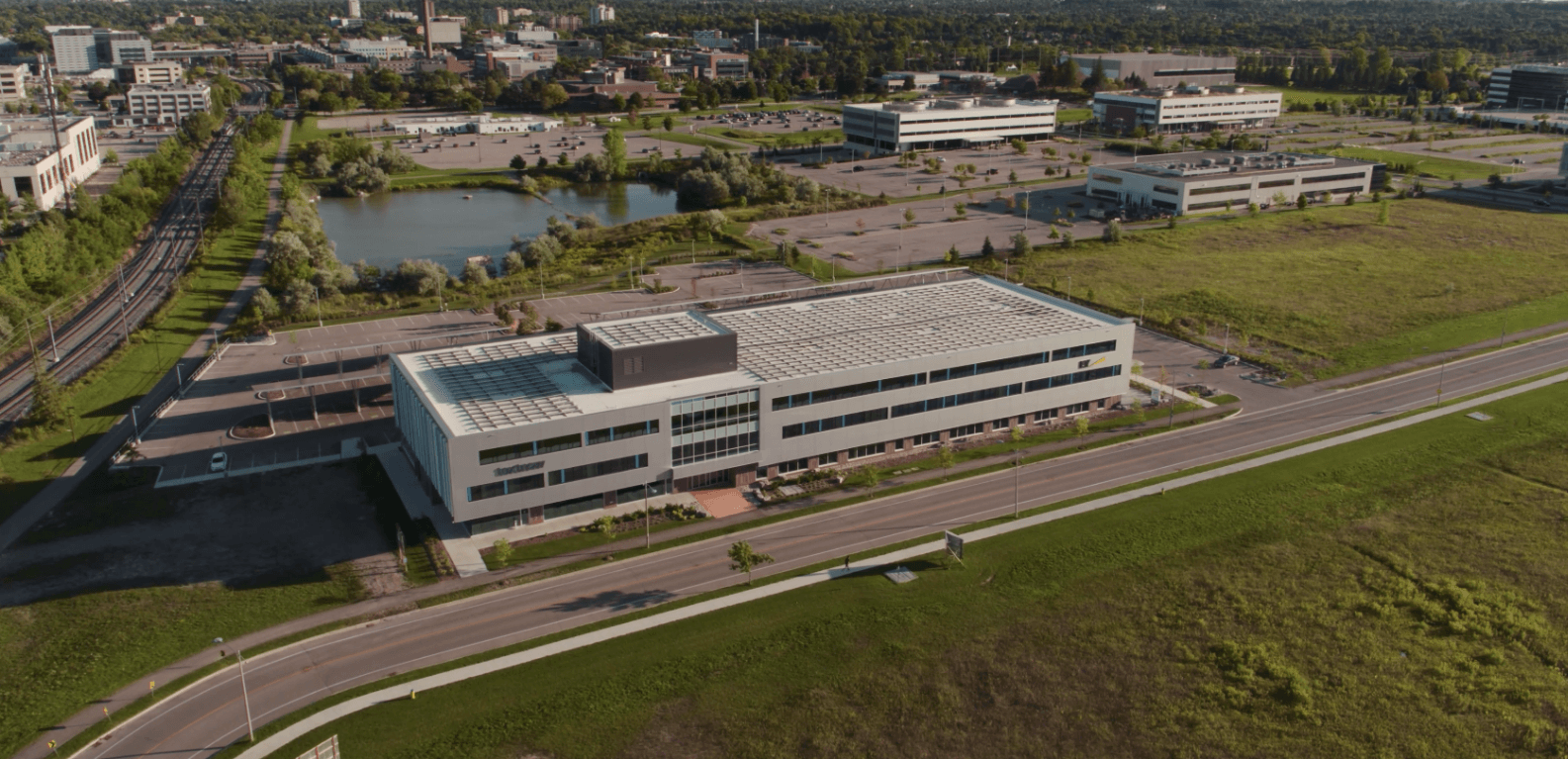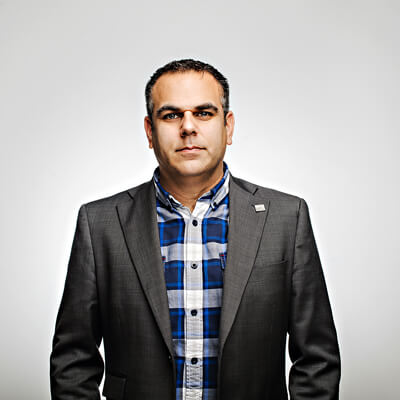Accelerator Centre welcomes 23 startups into the new UN Sustainable Development Cohort of AC:Studio
By: The Accelerator Centre Selected startups will receive up to $100,000 in seed funding and work with the AC and…

This interview was originally posted on the Waterloo Economic Development Website and is reprinted with permission.
Waterloo is known for its deep-rooted culture of collaboration between technology entrepreneurs, community builders and researchers.
In many ways the David Johnston Research + Technology Park (R+T Park) at the University of Waterloo (UWaterloo) is an embodiment of that collaborative culture and an example of its power in fostering innovation.
The 120-acre (49-hectare) park situated strategically on UWaterloo’s North Campus was announced in 2001 and opened its first building 2004. A relatively young research and technology park, it is already home to some of the biggest global names in technology, including OpenText and SAP.
The Accelerator Centre incubator in the Park has graduated many of the region’s most successful technology companies such as Clearpath Robotics and Miovision. R+T Park is currently home to a number of growing scale-up companies, TextNow and SSIMWAVE Inc., that are getting attention on the global technology scene.

We recently spoke to Mike Pereira, Manager of R+T Park, for a two-part Q&A series about the Park and the opportunity it presents for businesses looking to grow and innovate. Part one of our series explains the unique (and very recent) history of the park and takes a closer look at the current collection of tenant companies and organizations:
Q: Why did the University of Waterloo decide to build an R+T Park? What was the motivation?
Pereira: It is well-known that the University of Waterloo was founded by industry partners who wanted to create a school that forged strong connections between industry and researchers and develop the next generation of engineers and scientists. That spirit is still very alive at the University and R+T Park is set up to be at that intersection between industry, government and academia. It is a place where industries can plug directly into the research institutes and tap into the talent pool.
Q: There are many research parks in the world. Is this one unique?
Pereira: All research and technology parks tend to share a similar vision of connecting industries to a research and talent pipeline. But I think what really sets ours apart is apart is the collaborative partnership approach that the University of Waterloo has with industry. It’s the University’s propensity to innovate alongside industry that makes us different from a lot of other research parks. UWaterloo has a reputation for commercializing new ideas and bringing them into the market quickly.
Q: Beyond the large anchor tenants such as OpenText and SAP, can you describe the current occupants of R+T Park?
Pereira: We have an interesting mix of large corporations, growing startups and scale-up technology companies. For example, we have several engineering and consulting firms, including Stantec and Geosyntec Consultants.
There are scale-ups such as TextNow (a cloud-based voice and text service) and SSIMWAVE (with technology to enhance video streaming), Borealis AI (an RBC-backed artificial intelligence venture) and a number of research institutes and labs. There is very active academic research, in everything from quantum technology to sustainable energy and climate change, happening alongside company activities.
Then of course there is the Accelerator Centre, which at any given time is incubating in the neighbourhood of 100 startup companies, as well as organizations such as Social Venture Partners (a philanthropic network), Capacity Canada (supporting non-profit organizations) and Ontario Centres of Excellence (a government innovation agency), which all have offices here.
Q: So, is this really an environment that is fostering fortunate collisions between industry, academia, government and community organizations?
Pereira: Yes, that’s what we’re hoping — that we can create and foster those kinds of connections and collisions. We have formal ways of doing that. We have people in the university who are actively looking to develop those sorts of research and innovation partnerships. But we also run, for example, a volleyball league and a slow pitch league to get people out interacting and having fun in the same neighborhood, to encourage the informal collisions as well.
Q: What is the economic impact of R+T Park? Can you put a number on that?
Pereira: It is difficult to measure because a company like Open Text, for example, is going to be a huge success whether they are in R+T Park or not. And SAP is one of the most successful and largest tech companies in the world. They are growing and they do see the office in R+T Park as a strategic investment for growth, but obviously, the Park didn’t build SAP.
A lot of the economic impact is attributable to the university. The University of Waterloo Economic Impact Assessment report for 2019 by Deloitte just came out and it has really great data in there around the University’s impact on economic development.
What I can say is that the R+T Park has a really strong clustering effect. It allows like-minded companies to come together and co-locate, and that has been shown worldwide to generate strong economic outputs for regions.
The question we should ask is whether we would have the same strength of a tech sector if we didn’t have a very visible sign that we were very serious about research and development in the technology sector. I personally believe that the Park’s value is in being able to signify to the community here and around the world that we are very serious about building a world leading tech cluster. That is something we’ve been able to do in the past decade.

Q: Tell me more about the Accelerator Centre (AC). Do startups lease office space there and what does the Accelerator Centre provide to them?
Pereira: The Accelerator Centre was founded in partnership with the provincial and federal governments, as well as the regional and municipal governments and UWaterloo. It is its own unique entity, but it is a real gem to have in the park.
The way the AC is funded allows them to offer subsidized rent to startup companies. They also get a full suite of programming and mentorship services that these small companies would not be able to afford on their own.
The AC offers programs such as the flagship Accelerator Program (which walks the startup clients through the steps of building successful businesses). That has produced more than 65 Graduate companies that rank amongst the most successful tech companies in Waterloo Region.
There are also speciality programs, such as the TD Sustainable Future Program (that supports entrepreneurs working on cleantech), the Alexa Voice Tech Accelerator Program (for entrepreneurs advancing voice-powered technologies), and the AC JumpStart program (an early stage seed funding program).
Q: Is the Accelerator Centre successful?
Pereira: The Accelerator Centre has a company survival rate of 92 percent two years companies graduate from the program. By that benchmark, it is one the most successful incubators in the world.
There are probably in the neighborhood of 100 companies going through different programs at any given time.
The AC has won several awards including recently being named the number one incubator in Canada in the Digital Finance Institute’s Canadian FinTech & AI Awards (for the second year in a row).The recent University of Waterloo Economic Impact Assessment also noted that the companies graduating from the combined Accelerator Centre and Velocity programs contributed $170 million to Canada’s annual GDP and 7,500 jobs.
Read Part Two of Waterloo EDC’s Q&A series on R+T Park!